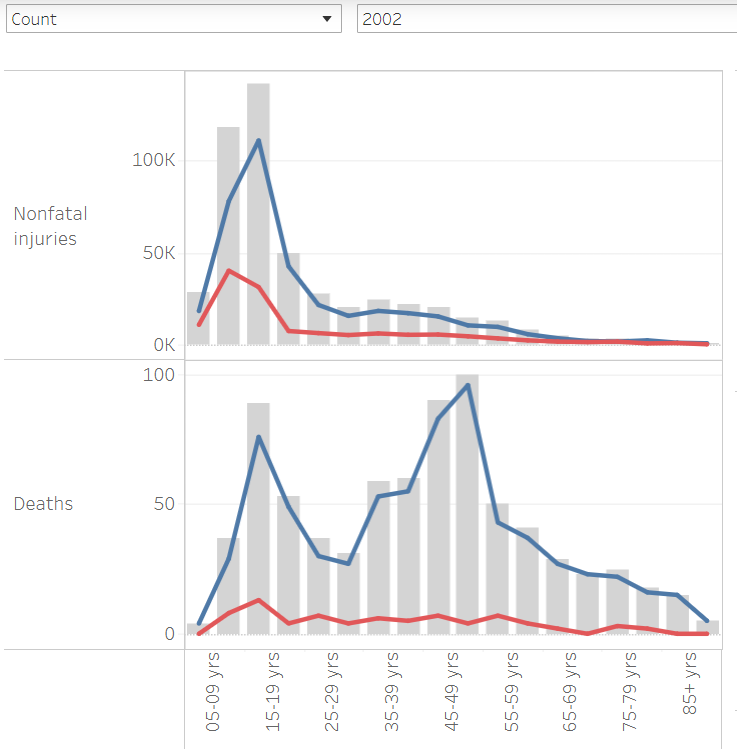Gordon Ramsay Shows the Danger of Bicycle Riding, and Importance of Helmets
The death stats show it, too
Here’s the news hook:
CNN: Gordon Ramsay says he’s ‘lucky’ to be alive, shows off severe bruising after cycling accident
Gordon Ramsay says he’s grateful to be alive but shaken after a recent cycling accident in Connecticut.
The famed TV chef said in a video posted to his Instagram page over the weekend that he “had a really bad accident” that “really shook me.”
….
“I’m lucky to be standing here,” Ramsay, an avid cyclist and triathlon competitor, said. “I’m in pain, it’s been a brutal week, and I’m sort of getting through it but I cannot tell you the importance of wearing a helmet.”
He said he believes the helmet “saved my life.”
I am not sharing the video. You can follow the link and watch it over there.
It reminds me of the bruise on my side from when I fell down on the sidewalk in Hartford (mine was much smaller, mind you. But it was that purple.)
So, of course, my mind went straight to cycling death stats.
Crude Death Rates for Pedal Cyclists, 1999-2022, U.S.
I’m going to use crude death rates in all the following, as there is little difference between the age-adjusted rate and the crude rate.
I always use rates, instead of actual counts, as the population grew quite a bit over these 23 years.
The ICD codes are a swatch of accidental deaths of “pedal cyclists” and a variety of methods of death. It gets a bit too detailed for the number of deaths involved, and some don’t even have much detail.
Let’s check out some demographic break-outs.
Cyclist Death Rates by Sex
As with many accidental causes of death, there is a huge mortality gap between males and females. The male-to-female ratio is about 7 to 8.
It’s difficult to notice, due to the difference in scales, but the percentage increase in cycling death rates for females was higher from 2019 to 2022 (33%) versus males (21%).
Cyclist Death Rates by Age Group
This one has an interesting disparity.
The under-25 rate has a decreasing trend throughout the period.
For those age 25-44, it’s kind of sideways, and the increasing trend at the end may or may not be pandemic-related. The increase seems to have started before the pandemic.
The other two groups show a clear increase from 1999 to 2022.
What’s going on?
Snapshots from the National Safety Council
The National Safety Council has a cycling statistics page, and it has information on nonfatal injuries, not just deaths.
Their statistics are simply counts, not rates.
Even so, I think some snapshots can inform us as to what is driving the different death rate trajectories.
Here is 2002 (Injuries on top, Deaths on bottom, and the lines are just male/female split.)
There are very different scales to the injuries and deaths graphs as there should be.
Kids have a lot of injuries in 2002, and relatively high deaths.
Injuries peak at the age of highest activity (childhood) and highest lack of judgment and coordination (childhood).
As people get older, injuries drop off. Mainly because fewer and fewer older folks bike. I don’t remember the last time I was on a bicycle.
Deaths have an interesting bimodal shape - one peak at that injury peak, but the other peak in middle age.
Let’s jump ahead to 2011.
The injury peak is still in childhood, when activity is highest. There still is a drop off of injuries with increasing age.
But the bimodal death distribution has not gone on so much.
Some of this could be a result of the demographics — Millennials, Gen X, and Boomers. That makes the most sense. This is why I prefer using rates.
However, some of the issue is that the relative peaks — what may be really going on here is that the older people getting in accidents may be less likely to survive them due to their older age. Or perhaps they’re less likely to wear helmets, as they grew up in the helmetless age.
It got really weird for the last two years in their dataset, but let me just share 2021:
Something really interesting has been going on. I am going to guess that during the pandemic, bike injury reporting may have been disrupted. Or, that the oldest folks are much less likely to go biking.
Perhaps middle aged people have been biking more, but biking in more dangerous areas and be less likely to be able to recover from their accidents.
The really interesting thing, though, is that it seems the youngsters have been much safer in their cycling activity. Yes, there are plenty of injuries still, but the peak is much reduced.











Helmets almost certainly have saved my wife's twice. First, when she was drafting me and a car turned right in front of us. I hit the brakes, she hit me, and she was on the ground, momentarily stunned, and helmet broken in two places.
Second time, years later, she let her mind wander while we were on a rails-to-trails thing. I moved to avoid an oncoming rider (on the wrong side), tires overlapped, and she vaulted over the handlebars. Significant concussion, broken shoulder, helmet split in six places. (Eventual full recovery.)
Absent the helmet, her skull would have been splattered over the pavement.
The under-25 rate has a decreasing trend throughout the period.
"For those age 25-44, it’s kind of sideways, and the increasing trend at the end may or may not be pandemic-related. The increase seems to have started before the pandemic.
The other two groups show a clear increase from 1999 to 2022.
What’s going on?"
Social media?
The rates seem to correspond to laws being passed to require bike helmets, at least for young kids. If you grew up wearing one, you probably continued. People my age did not, and when I see (an idiot) bike rider not wearing a helmet, he's likely to be my age. Strange that we'd make our kids wear them, but not wear them ourselves...